Rid your home of unwanted pests with guaranteed service from Eagle Pest Control.
Eagle’s pest control maintenance service is designed to keep you home pest-free by creating a protective barrier around the exterior of your home. We use extremely effective, long-lasting products that are safe to use in homes, schools, day cares, and food service establishments. Our full-service maintenance plans are inclusive of all general household pests. You will have a pest-free environment, both inside and outside of your home or business – Guaranteed.For Service calls and pricing, please call 502-243-1600
Ants
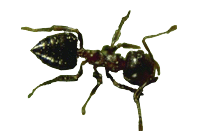
Acrobat Ant
The acrobat ant family includes several species. These ants are named for the curious acrobatic feat they perform - raising their abdomen up over their head almost like a scorpion, which becomes more apparent when they are alarmed. Acrobat ants are small, around an eighth-inch long and range in color from yellow-brown to dark brown. A stinger is present on these ants, but can be hard to see.
A key characteristic to look for is their heart-shaped abdomen, which attaches at the top to the waist. (see picture) Making their home both indoors and out, they usually build their nests in decaying wood. So sometimes a sawdust like material can be present around their nest. They have also been known to nest in various types of foam and insulation, but no matter where they nest they still need food. Trails of worker ants can be seen going between the nest and a various types of food sources, such as sweet or greasy substances.
Keep an eye out for swarmers (ants with wings) as these can be an early warning sign of an infestation.
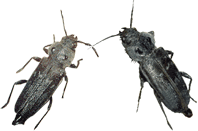
Argentine Ant
The argentine ant is very common and difficult to control. With the ability to build nests under just about anything, they can be a real nuisance.
Argentine ants are very small ants, around a sixteenth of an inch long. Color can range from light brown to dark brown, they have no stinger - but can bite. These ants sometimes crawl through unsavory conditions such as dead animals or garbage, so they can be carriers of disease.
This ant can be found indoors and out. They trail heavily to and from food sources. Inside they eat just about anything that can be found in the kitchen, while outside they eat things like other dead creatures, honeydew from other insects and bee honey. For them to nest inside they like a source of moisture, like under a kitchen sink, or in inside a potted plant.
Outside nesting places could be under rocks, garbage cans, concrete, or any place moist and sheltered from light.
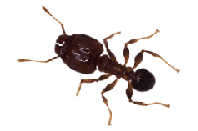
Bigheaded Ant
The bigheaded ant gets its name from the disproportionately large head of the worker, used to crack hard seeds and other prey.
Colors of the bigheaded ant range anywhere from yellow to almost black, and many combinations in between. Bigheaded ants aren't as common to find inside, although they occasionally enter homes.
They usually nest outside or under slabs. When they do enter the home, they tend to trail to protein-rich food sources like meats or peanut butter.
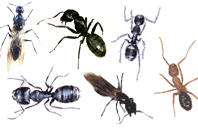
Carpenter Ant
Carpenter ants frequently make their homes by hollowing out wood to make galleries and nests, which is how they got their name. Carpenter ants tear wood and clear it out for nesting, they don't actually digest it like termites. These ants can also nest in wall voids, or other types of voids and build galleries through wood in your home.
Carpenter ants feed on the same sorts of things other ants do; other insects and household food items. There are different varieties of carpenter ants, ranging in color from black, to red and black, to red, to brown. Typically larger than most other ants, the size of a carpenter ant can be an indication of the size and maturity of its colony - bigger ants come from more mature colonies.
Keep an eye out for warning signs you may have a carpenter ant infestation. You may see the swarmers or their wings around window areas, workers foraging for food, or the debris pushed out of the galleries by the ants. This debris, called frass, collects in small piles and looks like sawdust. Frass can include bits of other building materials or insect body parts. Sometimes the makeup of the frass can be a tip off as to where the ants are nesting. Look for darker colored frass indicating nesting in decaying wood, or pieces of wall insulation or foam insulating board.
If you suspect you have carpenter ants, it is important to determine the location of the nest. If the nest is outside, a barrier should be sprayed around the house as well as localized treatments for the ants inside. If the nest is determined to be inside the home it can be controlled with traditional injections of pesticide in aerosol or dust form.
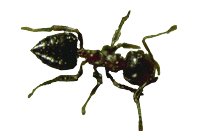
Field Ant
The field ant is a very large group of ants, making up a sixth of the ant population. They generally make their nests in mounds outside, but have been known to enter houses in search of food.
Field ants are fairly good sized, around 1/4" long, ranging in color from brown, to black, to red. It's typical to see these ants around cracks in the concrete, or you may see large numbers of light brown swarmers in the fall.
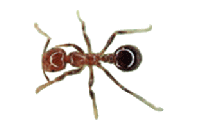
Fire Ant
Fire ants are named after their painful bites and stings, which can feel like fire. Typically smaller ants, around 1/8th of an inch long, they can be identified by their coloring.
The body of the fire ant is a light red color, and the abdomen will be darker. (see picture) Usually they will nest outside in a large, flat mound. But when fire ants nest inside they prefer warm places in wood or masonry, and eat just about anything. Fire ants have a strange attraction to metal electrical boxes, and in numbers they can cause electrical problems.
Finding and treating the nest can be especially important to control these pests.
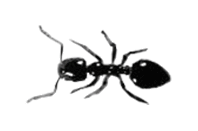
Little Black Ant
The Little Black ant has similar nesting habits to other ants, though it's biology is not very well understood.
It's name comes from the fact this ant is little, and black! (only 1/16" long) Common to this area, the little black ant feeds on many food items it can find in the kitchen.
Whether the nest is indoors or out, they can be seen trailing to a food source. If they do build a nest in your house, they prefer decayed woods - but can also build nests in voids or cracks in cement.
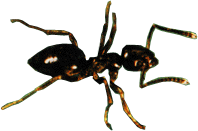
Odorous House Ant
The odorous house ant is named for the smell it emits when crushed. Similar to the smell of rotten coconuts, this odor can be useful to identify these ants. In the house they prefer sweet foods, but have been known to eat other things. Even though the name suggests these pests are common in the home, they are actually more of an outdoor pest.
They can nest in walls voids in the home, but are usually found outdoors in nesting locations similar to other ants; under rocks, logs, planters, etc. They have also been known to make home in nests of other, larger ants.
Baiting can sometimes be difficult, because of this ants reluctance to take different types of baits.

Pavement Ant
The pavement ant is named for it's preference to nest under sidewalks, or in cracks in cement. They are small ants, less than 1/8" long, ranging from brown to black in color.
Their legs are lighter in color than their body, which may be helpful in identifying them. It is common to see a mound or anthill around the cracks in cement where these ants live. Although not typical, pavement ants can nest in homes.
They have been known to nest in wall voids, or cracks in masonry especially in warmer areas of the house. These ants aren't picky eaters, and will feed on almost anything in the kitchen - making them a good candidate for baiting.
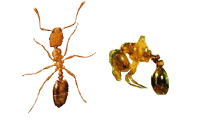
Pharoah Ant
The Pharaoh ant is believed to have come from Egypt, and named after the ancient plagues in the days of the Pharaohs. These small ants are only around 1/16" long, and are typically lighter colored with a darker abdomen.
They bear more of a resemblance to a wasp than other ants do. Pharaoh ants are notorious in hospitals and restaurants for infecting food and supplies. Nesting primarily inside, they prefer warm moist areas such as steam heating systems. You can see them trailing to various food sources similar to other ants.
Caution should be used with pesticides, or other things that may disturb the nest - as they can split up and form new nests just about anywhere. For this reason Pharaoh ants can be difficult to control.
A baiting program is usually most effective, having the least chance of disturbing the colony.

Small Honey (False Honey) Ant
The small honey ant, sometimes called the false honey ant, may be named for the fact it has been confused with the true honey ant.
This ant can be various shades of brown, and has a shiny appearance. Small honey ants are outside dwellers, but on occasion will nest close to structures and forage inside with a preference for sweet foods.
Cold weather is actually preferred by these ants, and they come out in temperatures close to freezing. Likewise, they aren't very active when it heats up in the summer.
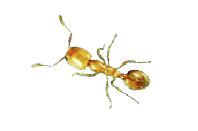
Thief Ant
The thief ant is named for the way it robs the nests of other ants for food, sometimes making home there. Thief ants are some of the smallest ants you will find, making them hard to identify.
They range in color from yellow to brown, and nest both indoors and out. Indoors you can find them nesting in voids and trailing to food sources, while outside they live mostly in the ground or in rotten wood.
They eat a wide variety of foods including dead animals, and can be an intermediate host for poultry tapeworm. Baits may not always be effective with these ants because of the limited quantities they ingest.
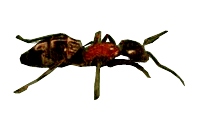
Velvety Tree Ant
The velvety tree ant is named for it's velvety abdomen, and making use of hollows in trees for nesting. This ant is fairly good sized, around 3/8" long, and can be identified by its red thorax.
Crushing a tree ant gives off a rotten coconut smell like the odorous house ant. However be careful, if disturbed they can inflict a painful bite.
These ants occasionally infest homes, leaving telltale frass behind as they clear out wood to make a nest. They do this similar to a carpenter ant, though not as damaging.
Velvety tree ants eat other insects, dead animals, and primarily sweet foods inside. Sometimes it can be necessary to apply a treatment to an infested tree.
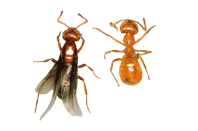
Yellow Moisture Ant
The yellow ant, also called the moisture ant, is named for it's color or attraction to moist areas. These ants are under 1/8" long, and smell of citronella when crushed.
Preferring to nest in the ground or in rotten wood, they are more of a subterranean insect. This, along with the fact they are primarily nocturnal, means they can go undetected for quite awhile. This ant builds large, mounded nests outdoors or sometimes under houses. Inside, they can make home anywhere there is a water leak or rotten wood, but won't disturb sound wood.
The yellow ant also builds nests of dirt colored material, which can be found in areas such as wall voids. Typically they won't feed on household foods, as they prefer to eat other insects and their secretions.
Additional resources are available to assist you in identifying and controlling insects.
Insect Identification
With over 1 million identified species of insects and spiders in the world with many more still awaiting discovery. Use Insect Identification categories to discover your species.
Pest World
For expert pest control tips and resources surf to Pest World.
Pest World for Kids
For fun pest facts and kid-friendly bug and insect research, head to Pest World for Kids.
